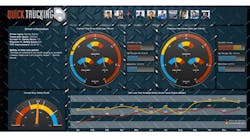Reshoring, supply chain visibility and labor-saving automation are hot topics among manufacturers. In fact over the past week we’ve seen new studies about these topics that, taken separately, report interesting trends, but when I tried to put them together into one big picture, the effort caused my head to ache..
Here are key take-aways from all three:
- More than one-third of U.S. businesses will move goods and services work back to the United States in the next 12 months, according to the results of Grant Thornton’s “Realities of Reshoring” survey. Part of this is because automation is becoming more affordable and relationships with overseas suppliers can hardly be considered partnerships (64 percent describe their supplier relationships as limited-value “buy and sell (i.e., transactional, focused primarily on cost)” exchanges;
- Globally, 27% of high-tech logistics executives surveyed by UPS are embracing near-shoring to improve their customer service. 77% said they wanted to improve service levels by bringing production closer to demand and almost 55% cited improving control over quality and intellectual property (implying that dealing with overseas suppliers makes those things difficult);
- Other high-tech executives, including 82% in the U.S., told UPS they will continue to use their existing offshore supply chain strategies. Survey respondents cited the cost benefits of low-cost manufacturing countries and the location of key suppliers as the top reasons for not considering near-shoring.
- According to Gartner's annual user wants and needs survey, supply chain visibility ranks top in companies’ investment priorities for technologies across their supply chain processes and in the top three challenges for achieving supply chain goals; Gartner states that end-to-end visibility requires three things: joint collaboration along processes supported by technology, integrated and harmonized information, and investments in multienterprise, multitier supplier and channel partner visibility.
So here’s the head-aching dilemma caused by mashing these three different reports into one head:
More and more companies seem interested in bringing their supply base back home, justified by more affordable automation and less trustworthy suppliers; they also want to improve customer service for their domestic markets. Still, the attraction of low-cost overseas labor remains an overwhelming incentive for other companies to continue sourcing offshore. But if those executives who talked to UPS are anything like the ones who talked to Grant Thornton, they don’t trust those suppliers any farther than they can throw them. And trust will be essential if manufacturers are to establish the supply chain visibility executives told Gartner they want and need.
It sounds like supply chain executive wants and needs are at war. But in talking to a couple of the people connected with these studies, there are nuances at play that need to be considered. For example, Wally Gruenes, Grant Thornton’s national managing partner for industry and client experience, said that labor-saving automation isn’t the only source of savings when companies reshore operations.
“Manufacturers have an appreciation for the synergies and learning benefits of having the manufacturing and R&D facilities in the same area or country,” he concluded.
And Ken Rankin, director of high-tech marketing for UPS, said that the days of pursuing “low-cost” labor as a company’s primary cost-mitigation strategy are coming to an end.
“High-tech companies are now taking a broader perspective, balancing cost, product quality and customer service,” he said. “In fact, 77% of the high-tech executives responding to our survey who are planning to near-shore stated that improving service levels, like reduced lead times, was a key driver in their decision.”
A global supply chain ultimately depends on partners who can communicate with each other and who can trust what’s being communicated. The information network may be enabled by automation, but like politics, all communication is local. You can’t automate trust. So whether you’re offshoring or nearshoring, put some time into face to face networking—both on the customer-facing and the supplier-facing sides.


